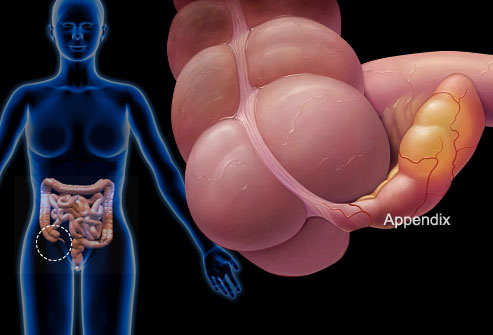
Acute pelvic pain is pain that starts over a short period of time anywhere from a few minutes to a few days. This type of pain is often a warning sign that something is wrong and should be evaluated promptly.
Pelvic pain can be caused by an infection or inflammation. An infection doesn't have to affect the reproductive organs to cause pelvic pain. Pain caused by the bladder, bowel, or appendix can produce pain in the pelvic region; diverticulitis, irritable bowel syndrome, kidney or bladder stones, as well as muscle spasms or strains are some examples of non-reproductive causes of pelvic or lower abdominal pain. Other causes of pelvic pain can include pelvic inflammatory disease (PID), vaginal infections, vaginitis, and sexually transmitted diseases (STDs). All of these require a visit to your healthcare provider who will take a medical history, and do a physical exam, which may include diagnostic
Quick Answers to Health Questions :
•Pelvic Pain Causes.
•OA Knee Pain.
•Pain Symptoms.
•Chronic Pain Center.
•Causes Endometriosis.
Women who have ovarian cysts may experience sharp pain if a cyst leaks fluid or bleeds a little, or more severe, sharp, and continuous pain when a large cyst twists or ruptures - this is probably the most common gynecologic cause of acute onset pelvic pain. Fortunately, most small cysts will dissolve without medical intervention after 2 or 3 menstrual cycles; however, large cysts and those that don't rectify themselves after a few months may require surgery to remove the cysts.
An ectopic pregnancy is one that starts outside the uterus, usually in one of the fallopian tubes. Pain caused by an ectopic pregnancy usually starts on one side of the abdomen soon after a missed period, and may include spotting or vaginal bleeding. Ectopic pregnancies can be life threatening if medical intervention is not sought immediately. The fallopian tubes can burst and cause bleeding in the abdomen, if left untreated. In some cases surgery is required to remove the affected fallopian tube.
Acute pelvic pain can also be a symptom of appendicitis.
Chronic Pelvic Pain
Chronic pelvic pain can be intermittent or constant. Intermittent chronic pelvic pain usually has a specific cause, while constant pelvic pain may be the result of more than one problem. A common example of chronic pelvic pain is dysmenorrhea or menstrual cramps. Other causes of chronic pelvic pain include endometriosis, adenomyosis, and ovulation pain. Sometimes an illness starts with intermittent pelvic pain that becomes constant over time; this is often a signal that the problem has become worse. A change in the intensity of pelvic pain can also be due to a woman's ability to cope with pain becoming lessened causing the pain to feel more severe even though the underlying cause has not worsened.
Women who have had surgery or serious illness such as PID, endometriosis, or severe infections sometimes experience chronic pelvic pain as a result of adhesions or scar tissue that forms during the healing process. Adhesions cause the surfaces of organs and structures inside the abdomen to bind to each other.
Fibroid tumors (a non-cancerous, benign growth from the muscle of the uterus) often have no symptoms; however when symptoms do appear they can include pelvic pain or pressure, as well as menstrual abnormalities.
Diagnosis and Treatment of Pelvic Pain
Due to the large number of possible causes of pelvic pain, diagnosis begins by process of elimination. Your physician may order several types of tests to diagnose the problem. It may seem tedious and time-consuming; however, this approach is the best way for your provider to determine the cause of your pelvic pain. Some of the tests that your physician may order include ultrasound imaging, computed tomography (CT), magnetic resonance imaging (MRI), intravenous pyelography (IVP), and
Barium enema. However, these tests cannot detect endometriosis or adhesions and laparoscopy may be necessary to diagnose the cause of your pelvic pain.
What type of treatment you receive depends on the diagnosis. Treatments can vary from medications for urinary tract infections (UTI) or vaginal infections to pharmacologic treatment in the hospital for serious infections such as PID. If a sexually transmitted disease is diagnosed, your partner will also need to be treated to prevent reinfection.
Menstrual cramps can often be relieved with drugs that reduce inflammation, such as ibuprofen, which blocks the production of prostaglandins that cause the uterus to contract. Sometimes the diagnosis will require the use of hormonal therapies including oral contraceptives and other types of hormones. Antidepressants are helpful for some women because they help break the cycle of pain and depression that often occurs in women with chronic pelvic pain.
Surgery may be the answer for certain types of pelvic pain. What type of surgery depends on the diagnosis. Surgery such as laparoscopy can be done on an outpatient basis, while other surgeries such as hysterectomy require a stay in the hospital. Your healthcare provider will discuss your options based on your diagnosis, as well as the risks and benefits of these procedures and the chance of them working. Hysterectomy is not always the best treatment, especially in the case of chronic pelvic pain.
Other treatments include heat therapy, muscle relaxants, nerve blocks, and relaxation exercises. If digestive or urinary conditions are diagnosed specific treatments for these conditions will be used.
Determining the cause of pelvic pain can be a frustrating situation for many women, but try not to give up. Even when one specific cause for chronic pelvic pain is not found your healthcare provider has treatments that can help. Maintaining an open working relationship with you physician is the best way to find the treatment that works best for you.